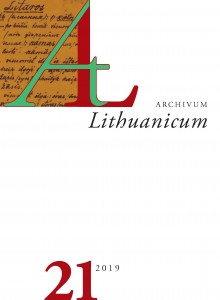Simono Daukanto Būdo recepcija Maironio Apsakymuose apie Lietuvos praeigą (1891)
Reception of Simonas Daukantas's Būdas in Maironis's Apsakymai apie Lietuvos praeigą (1891)
Author(s): Roma BončkutëSubject(s): Comparative Study of Literature, Lithuanian Literature, 19th Century, Theory of Literature
Published by: Lietuvių Kalbos Institutas
Keywords: Simonas Daukantas; The Character of the Lithuanian Highlanders and Samogitians of the Old Times; Jonas Mačiulis-Maironis;
Summary/Abstract: This article investigates the influence of Simonas Daukantas’s (1793–1864) book BUDĄ Senowęs-Lëtuwiû Kalnienû ĩr Ƶámajtiû (The Character of the Lithuanian Highlanders and Samogitians of the Old Times) (1845; hereafter Bd) on Jonas Mačiulis-Maironis’s (1869–1930) Apsakymai apie Lietuvos praeigą (Stories about Lithuania’s Past) (1891; hereafter ALP), which was reprinted in 1893 and 1906 as History of Lithuania. The fourth reprint in 1926 was titled Lithuania’s Past. Maironis’s work was popular and used as a textbook, so it had a significant impact on Lithuanian readers. Although the introduction “Užgyvenimo vieta” (“Place of residence”, p. 10) and chapters “Ukiszka vyresnybē” (“Heads of State”, pp. 18–19), “Pilēs ir miestai” (“Castles and Cities”, pp. 19–20), “Karionēs” (“Battles”, pp. 20–23), “Prekyba” (“Trade”, p. 23), “Namu gyvenimas” (“Home Life”, pp. 23–26) are obviously based on Daukantas’s Bd, the author never mentions this fact. Moreover, it seems that Maironis was influenced by Daukantas’s style, which he emulates, at times employing the elements of essay and poetry, or using long rhythmic sentences, which are sometimes reminiscent of hexameter and other times of Lithuanian folk song melodies and rhythms. Along with a significant part of Daukantas’s style and vocabulary, Maironis absorbed his dominant themes, motifs, personalities and places, images of daily life and nature. Maironis not only repeats all this in his ALP but also transfers them to his poem Lietuva (Lithuania).
Journal: Archivum Lithuanicum
- Issue Year: 2019
- Issue No: 21
- Page Range: 165-192
- Page Count: 28
- Language: Lithuanian

